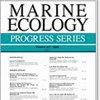Habitat-mediated direct and indirect interactions in a marine sedimentary system from Atlantic Canada
IF 2.1
3区 环境科学与生态学
Q2 ECOLOGY
引用次数: 0
Abstract
ABSTRACT: Trophic cascades focusing on direct (consumptive) effects have been well studied in marine ecosystems. However, less attention has been given to cascades involving indirect interactions embedded in distinct habitats. We focused on the interactions between a non-indigenous predator (the green crab Carcinus maenas), a consumer (the mud crab Panopeus herbstii), and a prey species (juvenile eastern oysters Crassostrea virginica). These interactions were studied in 3 small yet distinct habitats of increasing complexity: bare sediments, patches of blue mussels Mytilus edulis (BM), and a unique habitat consisting of giant Irish moss Chondrus crispus and mussels combined (IMBM). In the field, green crab predation rates on mud crabs were estimated in each of the abovementioned habitats using tethering experiments. The results showed that green crab foraging was most effective in bare sediments and least effective in IMBM, i.e. the least and most complex habitats, respectively. Trials conducted in the laboratory with mud crabs foraging over oysters showed a similar outcome: oyster mortality rates declined with increased habitat complexity. However, when trials were conducted in the presence of a green crab, this pattern reversed, and oyster mortality was lowest in bare sediments. Mud crab behavior was consistent with these results: in the presence of a green crab, mud crabs were less active and spent more time sheltering, whereas in its absence, the opposite pattern was observed, especially in bare sediments. These behaviorally driven indirect interactions are dependent on the presence of a non-indigenous predator and mediated by the type of habitat.加拿大大西洋海洋沉积系统中以生境为媒介的直接和间接相互作用
摘要:在海洋生态系统中,以直接(消耗性)效应为重点的营养级联已经得到了很好的研究。然而,人们较少关注涉及不同生境中间接相互作用的级联。我们重点研究了非本地捕食者(青蟹 Carcinus maenas)、消费者(泥蟹 Panopeus herbstii)和猎物物种(幼年东部牡蛎 Crassostrea virginica)之间的相互作用。研究人员在复杂程度不断增加的三个小而独特的栖息地中对这些相互作用进行了研究:裸露的沉积物、成片的蓝贻贝(BM),以及由巨大的爱尔兰藓Chondrus crispus和贻贝组合而成的独特栖息地(IMBM)。在野外,利用系绳实验估算了青蟹在上述每种生境中对泥蟹的捕食率。结果表明,青蟹在裸露沉积物中的捕食效果最好,而在IMBM中的捕食效果最差,即分别是最不复杂和最复杂的生境。在实验室进行的泥蟹在牡蛎上觅食的试验也显示了类似的结果:牡蛎死亡率随着栖息地复杂程度的增加而下降。然而,当试验在青蟹在场的情况下进行时,这种模式发生了逆转,牡蛎在裸露的沉积物中死亡率最低。泥蟹的行为与这些结果一致:在有青蟹的情况下,泥蟹不太活跃,花更多的时间躲避,而在没有青蟹的情况下,则观察到相反的模式,尤其是在裸露的沉积物中。这些行为驱动的间接相互作用取决于非本地捕食者的存在,并受栖息地类型的影响。
本文章由计算机程序翻译,如有差异,请以英文原文为准。
求助全文
约1分钟内获得全文
求助全文
来源期刊

Marine Ecology Progress Series
环境科学-海洋学
CiteScore
5.30
自引率
8.00%
发文量
238
审稿时长
3 months
期刊介绍:
The leading journal in its field, MEPS covers all aspects of marine ecology, fundamental and applied. Topics covered include microbiology, botany, zoology, ecosystem research, biological oceanography, ecological aspects of fisheries and aquaculture, pollution, environmental protection, conservation, and resource management.
 求助内容:
求助内容: 应助结果提醒方式:
应助结果提醒方式:


